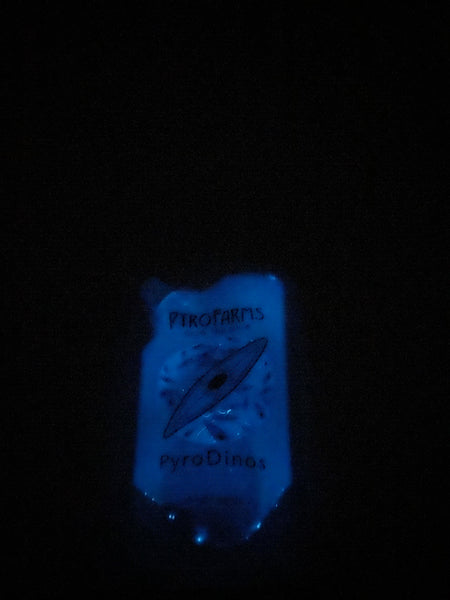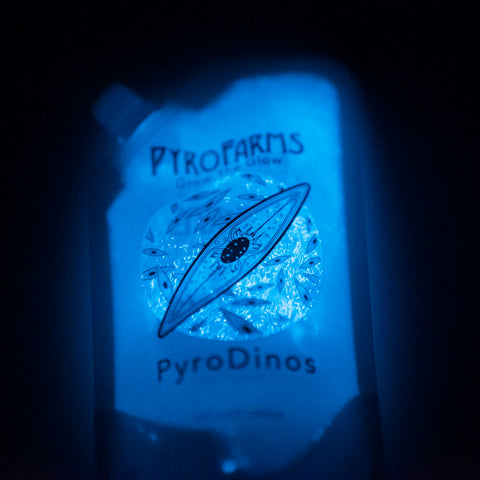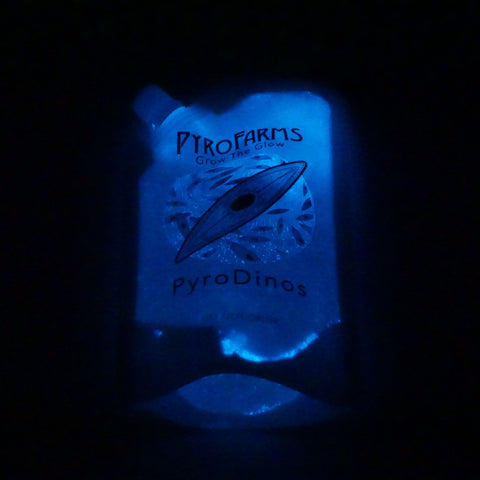Taking pictures of Bioluminescence

Taking pictures of natural bioluminescence can be tricky if you do not have the right camera. Natural bioluminescence is a faint light source. Fortunately, the cameras in our smartphones have improved dramatically over the past couple of years and have improved their low light capabilities. Still, there are some limitations even with the newest smartphones.
In this report, we will evaluate past and present Apple iPhone cameras as well as a recent Samsung Galaxy smartphone camera. And two Sony DSLR cameras will be included for reference. We will provide tips on how to take the best bioluminescent (low-light) photos.
All images are of PyroFarms' PyroDinos (bioluminescent dinoflagellates). Two identical PyroDinos pouches of equal cell density were used. Bioluminescence was triggered by tipping a standing pouch backward to elicit light from the dinoflagellates in the pouch
In this image below we used an Apple iPhone 7 in its standard configuration. The fact that you can actually see some bioluminescence in enough definition to identify the object is a big positive. Past iPhones have failed to do this.
Tips:
Make sure the room absolutely dark (no contaminating light).
Turn off flash, turn off Live photo.
Hold the phone steady during the exposure.
iPhone camera apps
You can purchase iPhone apps that can provide more control over your camera settings. These will increase the quality and brightness of the low light images. The most important setting to control is exposure time. Apps that allow control over exposure time will be your best bet. Longer exposures allow more light and an overall brighter image. Other apps layer multiple images to digitally mimic longer exposures. We tested one of these apps, Neural Cam, which layers multiple images. We found a significant enhancement using this app.

above: Neural Cam app with iPhone 7
Tips: Hold the iPhone very still as the app takes several images and then digitally layers them. Use an iPhone tripod or stand to minimize movement.
Apple iPhone 11
The Apple iPhone 11 made a tremendous leap forward with its onboard camera. This is an amazing camera that begins to rival traditional DSLR cameras for standard daylight pictures. The image quality is outstanding (No.. Apple is not paying me anything) and the ease of use is impressive. There are just too many features to cover so we will stick to low-light. In low-light situations, the iPhone 11 excels in the smartphone class of cameras. This photo (below) was taken without any ancillary apps or enhancements.

The one setback is that you can not pre-focus in the dark (at least I am unaware of how to do this without using an app). So this image is a little out of focus.
Update- The iPhone 12 and higher versions are doing a much better job at capturing bioluminescence. The biggest difference is video. You can actually capture video using these new iPhones. Here is an example using an iPhone 12
Now for the real deal 'DSLR' cameras (Digital Single Lens Reflex). These are traditional single-lens cameras that allow full manual control and focusing which are very important when taking bioluminescent pictures. We will review two Sony cameras in their optimal mode for low-light bioluminescent photography. Sony alpha 6000 (a6000) and The Sony alpha 7S II (a7SII).
Here is an unaltered image from our Sony a6000
lens: f/3.5-5.6 16-50mm
manual focus and settings: 20,000iso, f/5, 1/40 exposure
The Sony a6000 does a great job of capturing the entire image in focus. By using a smaller aperture (f/5), the amount of light entering the camera is lower but the depth of focus is increased to capture the entire PyroDino Pouch. A quicker exposure is a luxury with high 20K iso. This shorter* exposure time limits the blur associated with longer low-light exposures of moving subjects. (*1/40 is short for low light).
The Sony alpha 7S II
Now for one of the premium low-light cameras and one of the best out of the box cameras for low light filming, The Sony a7SII. Lens: 50mm f/1.4

manual focus and settings: 20,000iso, f/1.4, 1/100 exposure
You can see individual dinoflagellates as they bounce around in the pouch! The plane of focus is limited with the wide f/1.4 aperture but all that extra light allows us to progress to shorter exposure time, (1/100), and capture the image frozen in time. If this was a product shot, I would have backed off the narrow f/1.4 plane of focus and used an aperture setting of f/3 or smaller (to capture the whole pouch in focus). This is all doable with the ultra-high iso of 410K on the a7SII.
Send us your PyroDino Pouch photo using a smartphone or DSLR camera and we may include it in this post.
last updated 02/14/2023
See photography and video of bioluminescence in nature
Best places to see marine bioluminescence





Comments
Beth —
Where is the Samsung?
Tabitha Serrano —
Thank you for this post! I’m going to see a bioluminescent bay in Puerto Rico and was not sure if I would be able to take pictures. I have the Sony a6000, so it seems I may have to take it with me. I also have the Apple 8, have you been able to test an Apple 8? Although from the 7 and 11 that you tested it seems my pictures might come out similar with the 8.